A viable app monetization model leads to an increased return on investments, which is achieved when the potential value of a new user is higher than the costs needed to acquire them. However, your monetization strategy should seamlessly merge with the mobile user experience. Even minor imbalances can make users remove your app. In this post, we’ll get a closer look at both ad-based and ad-free monetization models and the factors one should consider when looking for the silver bullet.
App monetization models can be largely divided into two broad categories: apps that rely on revenues from advertising and those that opt for other sources of income.
Ad-based model
According to the AppAnnie’s The State of Mobile 2019 report, this year will see a 60% increase in companies choosing in-app ads for monetization.
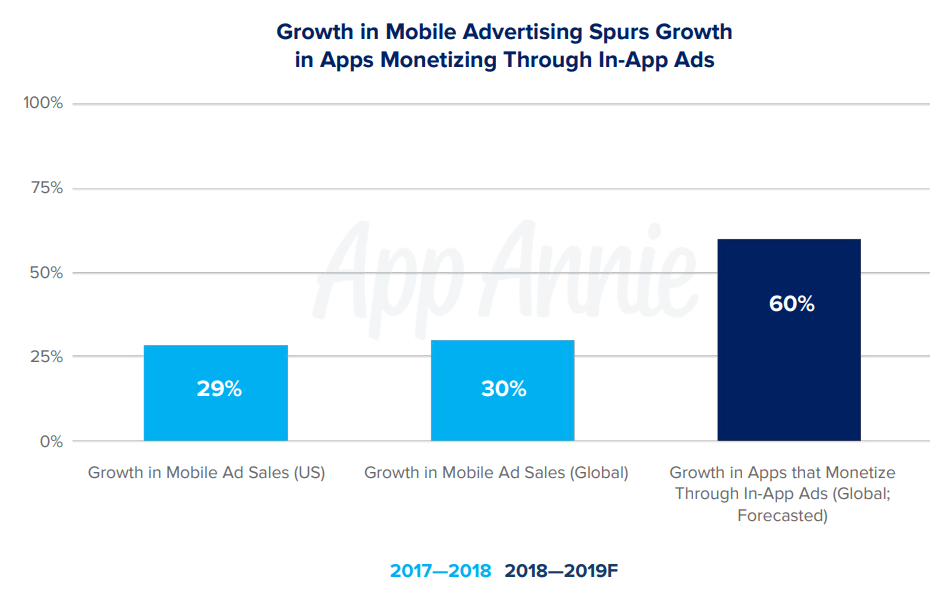
With in-app ads model, your business makes money through providing brands with paid advertising space. The technique is especially valuable within apps that have a large audience with frequent visits and long app sessions.
In fact, 4 of every 10 users of the top 100 apps and games in the US in 2018 were acquired through paid advertising. At the same time, the total number of downloads driven by paid ads increases 10% year over year across both iOS App Store and Google Play in the US.
As the majority of app users are not that eager to splash their money, ads within an app also allow them to access the functionality for free, thus erasing the price barrier.
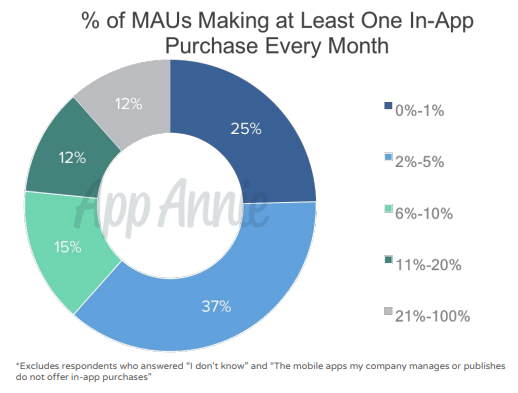
App vendors usually choose between the following types of in-app ads:
Banner ads are the most common types of in-app ads, that are positioned at the top or at the bottom of the screen. However, as 60% of clicks on mobile banner ads were made accidentally, users get annoyed and frustrated.
Native ads are perceived as the most flexible ad format that smoothly integrates with the app’s look and feel. A decent native ad looks more like an engaging part of content than a traditional ad.

The research has also shown that native ads are 2x more effective for user engagement than other formats. Moreover, “people engage more with native ads than standard banners, with an uplift in engagement between 20%- 60%.”
Full screen (or interstitial) ads may come in a static (images) or dynamic (videos) form and show up at natural transition points after completing a certain activity. This type of ads has a higher click-through potential, as the user should either tap on the ad to follow the link or close it and come back to the app screen.
‘Interstitial ads are best suited for apps with linear user experiences. There should be very clear starting and stopping points in an app. If you have an app that may not meet this criteria (e.g., utility apps like flashlight apps), consider using another AdMob ad format such as a banner ad.’
Google
Video ads serve as a promotional presentation in either a full-screen format or as a native ad.
Video apps have also shown the greatest revenue-generating results due to its popularity in gaming apps (57%).
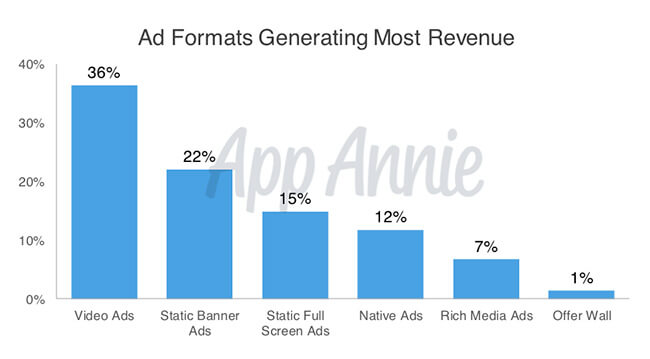
For non-gaming apps, the major profit drivers were static banner ads (35%), followed by video (18%) and native ads (16%).
However, the majority of users say that video and static full-screen apps are the most likely culprits for a negative app experience, as the app won’t function while they are shown.
Offer wall & rewarded ads encourage users to perform some action like watching a video, downloading another app, playing a game or making a purchase (for offer walls) in exchange for some bonuses.
Gaming apps particularly benefit from these adds with rewards in the form of extra lives, game currencies, and other gifts.
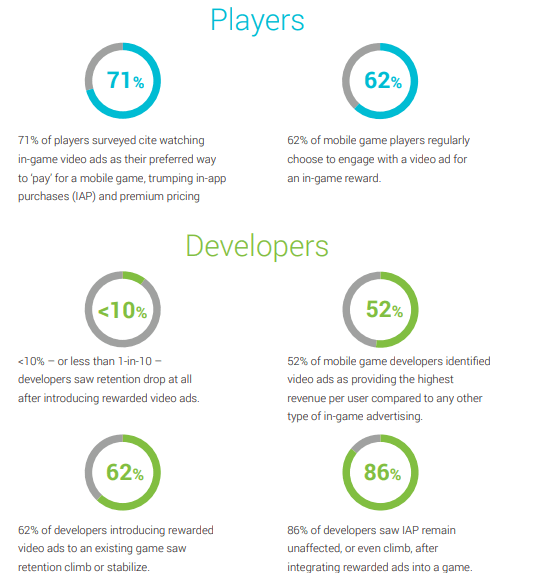
The model is successfully applied to non-gaming apps as well. One of the examples is Spotify, which offers users to watch a video add and get thirty minutes of ad-free listening.
Rewarded video ads help businesses to reduce their reliance on in-app purchases to monetize their users.
Depending on your app type, audience, the offer, and the advertising partner your revenue may be generated based on the following pricing models:
- Cost per mille (CPM) - for every 1000 times an ad is shown;
- Cost per click (CPC) - for every time an ad is clicked;
- Cost per action (CPA) - for clicks that lead to a certain action;
- Cost per view (CPV) - for having a video ad played;
- Cost per install (CPI) - for every advertised app installed.
Increased number of businesses leveraging ads leads to enhanced competition and requires matured advertising strategies. And as 66 % of users said that their encountered banner ads were useless, it is essential to ensure that promotions are relevant for targeted users and do not deteriorate in-app experience.
Ad-free monetization models
Premium
Premium apps require an upfront payment before download. As a result, app vendors are less affected by user retention rates and lifetime value. However, with so many free alternatives (around 90%), your app should offer exclusive content and boosted functionalities that give you an edge over competitors.
This monetization model works best for businesses that have already gained wide recognition for delivering a certain service.
For example, PlantSnap Pro: Identify Plants allows users to instantly learn the name of a plant with a photo or through an AR interface. The database currently contains 90% of all known plant species and is continuously enriched.
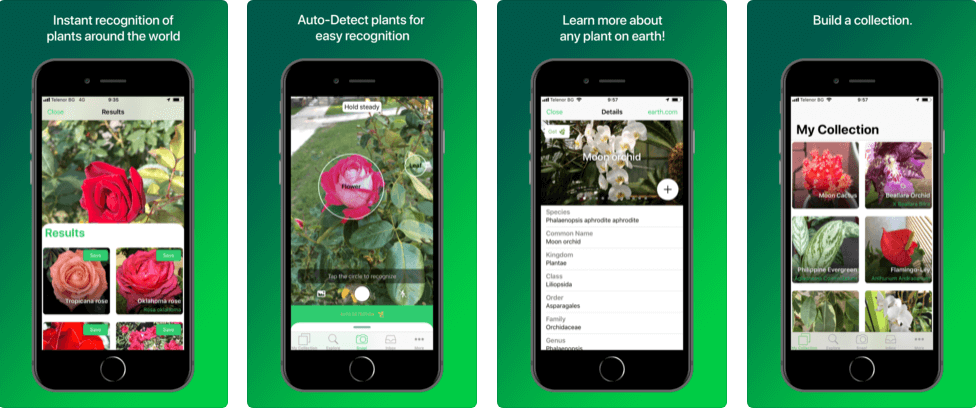
Freemium
The basic idea of freemium mobile apps is to provide users with a standard, but functional product for free, while encouraging them to upgrade to a more advanced version with premium content and features. This approach allows to attract a large user audience and satisfy their desire to see the value of what they buy.
The main challenge for freemium apps is to find a perfect balance between baked-in and paid features. As freemium apps are highly dependent on user engagement, they should show their worth without imposing anything on the user. The free version should give enough value to attract users and convince them to purchase.
Fortunately enough, global consumer spends are constantly increasing, as App Store marked a whopping $101B revenue in 2018, up 75% from 2016.
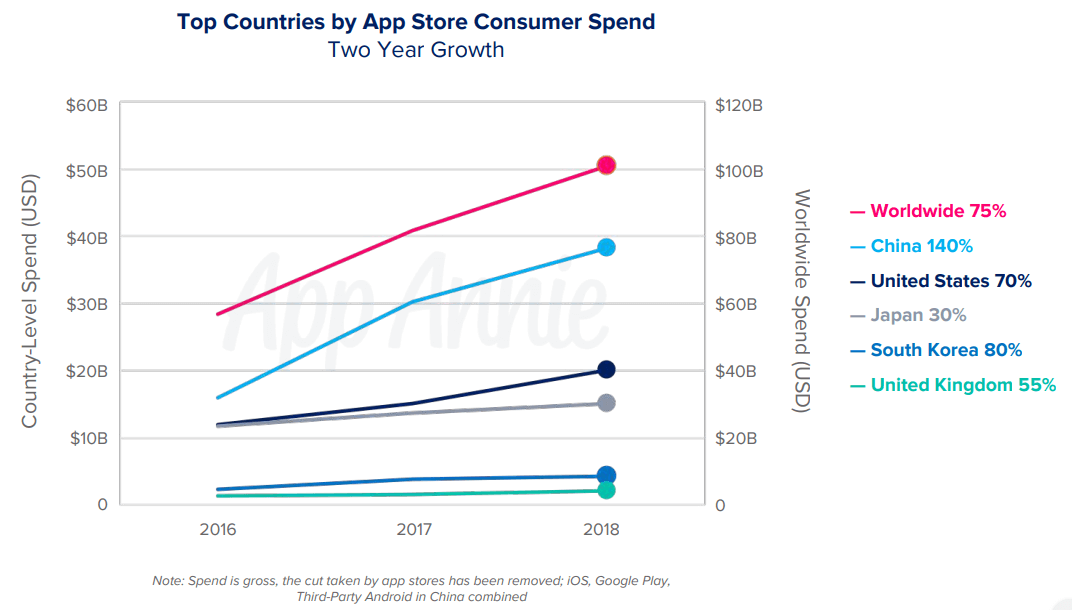
As seen from the table below, premium promotions come in all shapes and sizes. Yet, all of them are unlocked on either an in-app purchase or subscription basis.
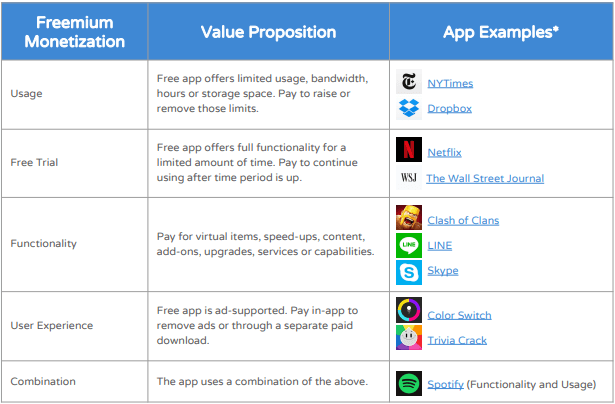 Source: App Annie App Monetization Report
Source: App Annie App Monetization Report
In-app purchases (virtual goods) may be for one-time (e.g. game credits) or lifetime use (e.g. ads removal, extra features, etc.) A popular augmented reality app Pokémon Go offers users a variety of digital goods like PokéCoins.
Yet, app owners should thoroughly consider their pricing schemes, as both Apple and Google charge 30% off every in-app purchase.
The subscription model allows users to upgrade to a premium version of an app that provides additional features. These apps are a good fit for industries that offer dynamic content like news, music, dating apps, etc.
The model is well-received by users, with conversion rates increased by 32% from 2.5% (2017) to 3.3% (2018), according to 2018 Liftoff App Engagement Index. Meanwhile, the cost of acquiring a new user has dropped by almost half from $86.99 to $46.4.
Moreover, both Apple and Google encourage the growth of this model, by reducing the transaction fee for subscriptions from 30% to 15%.
The top 5 most lucrative non-gaming apps of 2018 offered in-app subscriptions.

‘The rise in subscription app engagement is a boon for developers, as the subscription app model provides them with more consistent revenue streams. That’s because subscription apps generate revenue from recurring weekly or monthly payments from established consumers, rather than unpredictable, one-off purchases, for example.’
2018 Liftoff App Engagement Index
To increase retention rates for paying customers, developers can also offer lower rates for users that subscribe for a longer period.
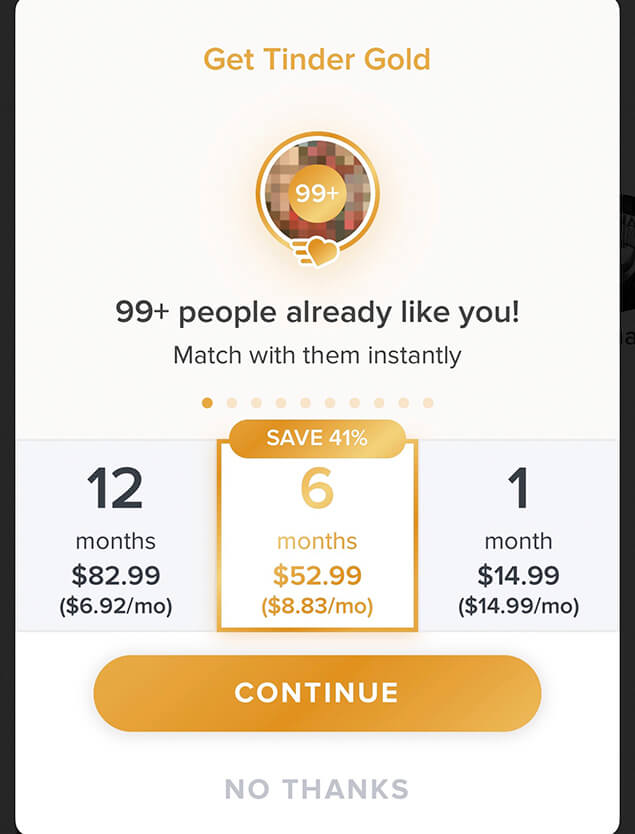
The users also appreciate when an app offers a number of plans to select from. This way, they can choose the set of features they need without overpaying for something they won’t use. A free trial can give an insight into your value proposition and benefits.
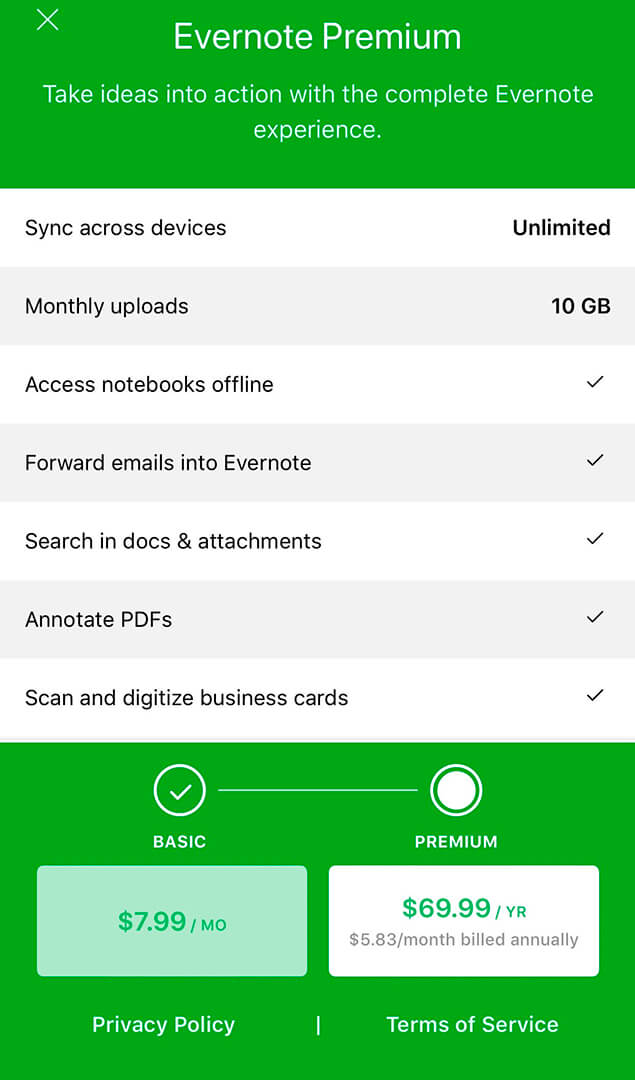
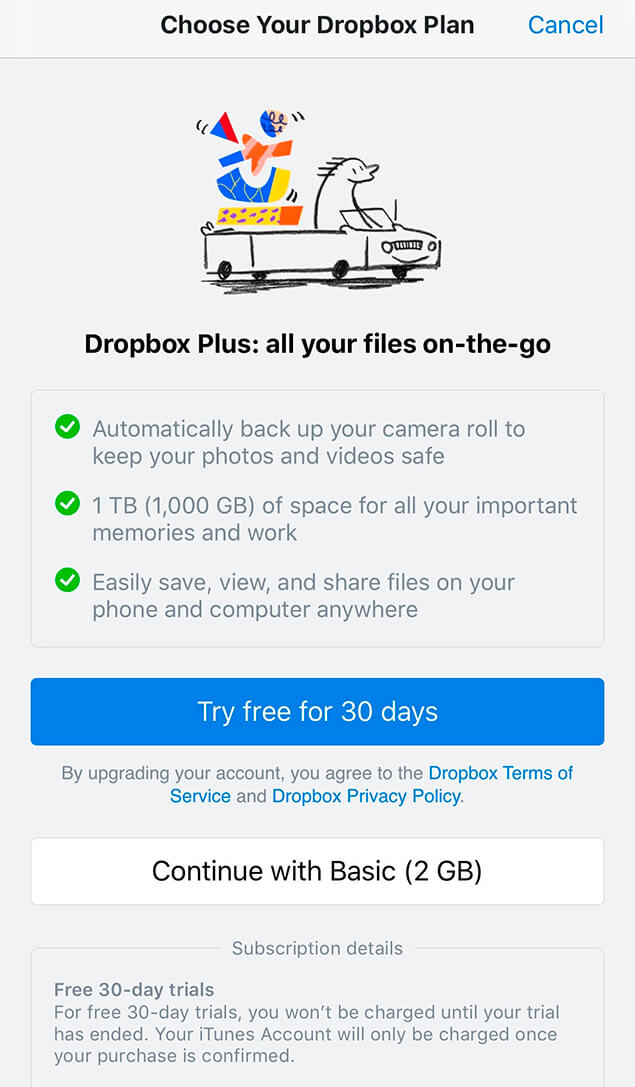
Paid transactions
Paid transactions are a natural source of revenue for apps that operate as digital marketplaces where financial operations occur regularly.
Payments apps like Paypal and Stripe get their revenues from charging users a fee for every completed transaction.
Similarly, booking.com charges accommodations for every successful reservation through their platform.
Data monetization
App data monetization is the process of gathering, processing and transferring of non-personal user’s data to data collectors. Advertising and marketing agencies, brands, research institutes, and telecom companies usually act as data collectors, as their business largely depends on knowing what people do.
It is important to remember that data monetization is about selling only the non-personal information, such as device type and OS version, screen size, mobile operator and network type, country, etc.
However, even though you can not identify the person with the help of non-personal data, you still have to explicitly ask the user for their permission through a consent form.
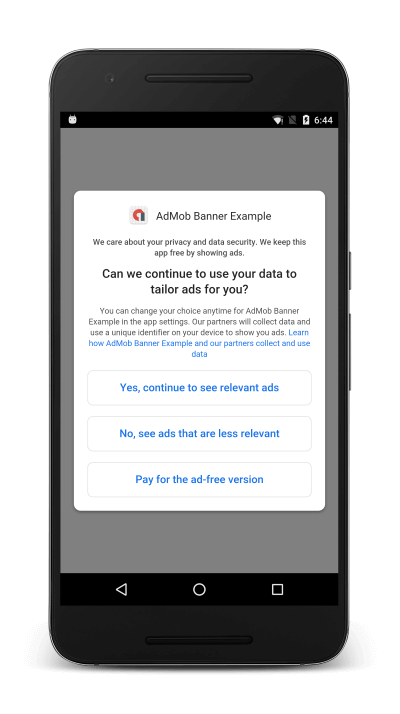
As the revenue from data is closely tied to the number of users who share it, the model is only suited for apps with high engagement rates that have at least 50 000 daily users.
‘The best part of data monetization is the app developer gets paid for the same users over and over again. The more DAU you have, the more appealing your app is to investors.’
Epom Apps, a monetization platform provider
To enable data gathering, app developers should add a data monetization SDK. After this, the data collection will take place in the background without hindering the user experience.
For example, a free location data app Foursquare gathers the information about users’ location, compiles it in massive databases and sells to businesses that want to optimize their campaigns.
Paid API access
Application programming interfaces (APIs) are a set of routines, protocols, and tools that enable developers to access features they need to build an app.
When you have developed an app that provides an innovative functionality or solves a problem that may drive interest from other companies, it is time to cash in on your API.
Some companies offer their APIs for free, aiming to create a larger developer community around their app. Walgreens suggests its core services (e.g filling prescriptions or ordering photo prints) as APIs. It enables Walgreens to “extend its brand presence into ecosystems it neither owns nor had to build”.
When the API delivers unique data or features, it makes sense to start to charge for its access to get direct value.
That was the case with a weather data provider AccuWeather. The company gained great success from sharing its APIs that were integrated into a number of apps from global vendors.
Yet, the company wanted to reach also small businesses and individual developers. For this, AccuWeather created a developer portal with API-packages each with their own rate limits and pricing.
Key takeaways
- In-app ads (banner, native, video, offer wall and rewarded) allow you to get money for ad space and remove the price barrier for users. However, their excessive use hampers app experience and may lead to high abandonment rates.
- Premium apps charge for download. Such apps should provide exclusive content and buffed experience to convince users to pay.
- Freemium apps offer a standard functionality for free while asking users for payments to unlock additional functionalities. Upgrades are provided either as in-app purchases or subscriptions.
- Paid transactions have good monetization potential for payment apps and apps that serve as an online marketplace. The idea is to charge a fee for every successful transaction.
- Data selling is a good way for apps with a large user base to profit without degrading the user experience. With a lightweight SDK users’ non-personal data is transmitted to interested parties. However, explicit user consent is obligatory.
- API access can bring you revenues if your app has unique functionalities.
Most top companies opt for a multi-pronged approach that combines two or more of these monetization models. It enables them to cater to a diverse user base and get higher revenues. Mobile A/B testing can give marketers worthy insights into user behavior patterns and preferred mobile app monetization model.
Recommended posts
Our Clients' Feedback






















.png)
.png)
















We have been working for over 10 years and they have become our long-term technology partner. Any software development, programming, or design needs we have had, Belitsoft company has always been able to handle this for us.
Founder from ZensAI (Microsoft)/ formerly Elearningforce